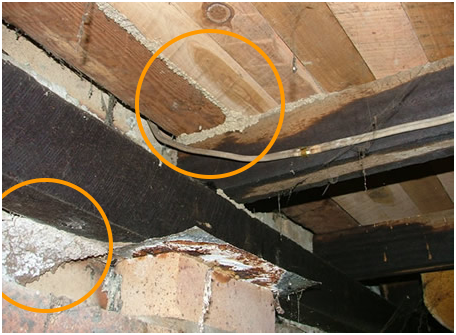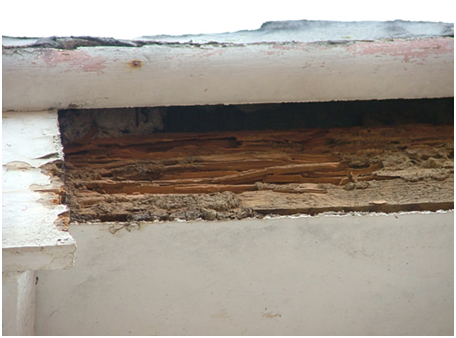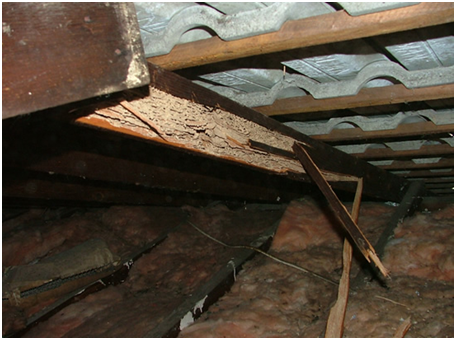Termites can affect anyone, anywhere at any time. Effective Building & Pest Control offers all our clients a range of Termite Control Procedures and products.
Call Effective Building & Pest Control Company now, for a professional Termite Inspection so we can determine if you have a termite problem or are potentially at risk of a Termite infestation.
With all of our Termite Inspections we guarantee to answer all of your Termite control questions and leave you with a better understanding about Termites and different Termite Control procedures.
Below you can find brief information about Termites, Termite Control Procedures and their products. Additional Termite Information can also be found at the bottom of the page with website links relating to the Termite Procedures we carry out and the registered Termite Control Products we use.
Termites in Australia
In Australia there are over 300 different species of termites, of these only six termite species are largely responsible for attacking timber in service, such as our homes and commercial premises. Termite damage bills alone can amount to over $100 million each year. This termite damage bill is greater than that caused by fire.
A large termite colony can cause a significant amount of damage within 12 months. The Australian Standard 3660 recommends homes and other structures have at least annual termite inspections to minimize building damage and expensive building repairs in the future. If you haven’t had a licensed termite inspector carry out any inspection in well over a year, then book a termite professional right away.
In addition to these termite inspections, owner vigilance, including checks are important. See handy hints below for more information on how you, the owner can keep a watchful eye on your own property.
Handy hints – Termite identification
Always check all timber frames inside the home, i.e.: Skirting boards, architraves, mantle pieces, timber floor and window frames. Look for blistered paint, rippled or bulging wall linings or mud packing emerging from timber joints or Gyprock walls.
For external perimeters or subfloor areas, check for termite mud galleries (small mud tunnels) against foundation walls, piers and edges of concrete slabs.
These are High Risk Areas to be aware of so you can minimize the risk of termite attack:
- Formwork timbers left beneath suspended concrete patios,
bathrooms, fireplaces and steps - Stored timber or cardboard in contact with the ground in subfloor
- Stored timber alongside the house should be stored away as far
as possible - Inaccessible areas or low to ground flooring voids where a thorough inspection is impossible
- Construction of retaining walls with railway sleepers;
Bush land and / or large trees in close proximity to your home
Damp soil – due to poor drainage, lack of cross flow ventilation, leaking pipes or shower recesses;
If any of these above areas are related to you, make sure you get one of our licensed and experienced Termite consultants to carry out a full termite inspection, supply you with a written report and give you recommendations to reduce or remove high risk areas.
Termite biology
Termites are social insects and live in colonies which can number 100’s of thousands. Each colony has a King and Queen. The Queen can lay up to 2,000 eggs per day. The workers and soldiers are castes most commonly encountered when termite activity is discovered which can be up to 100 meters from the nest.
They work 24 hours a day. They travel through mud shelter tubes to keep them hidden from predators such as spiders and ants but also enable them to avoid drying out and dying.
Termite colonies release winged reproductions called Alates. These Alates can become Kings or Queens. They have a darker body than normal termites. Termites in general have a typical whitish often almost clear body.
In spring on warm humid evenings, these Alates swarm from their nesting sites out of trees, stumps, telegraph poles and even within houses to find their own locations to provide their own colony.
The workers are the sterile males and females that feed the colony, rear the young and they enlarge the nest. They are the only castes that can chew and digest cellulose in wood.
The soldiers are sterile males and females. Their main function is to protect the colony. Soldiers cannot feed themselves and are dependent on the workers for their nutrition.

Termite control solutions
Most Pest Control Companies use the same chemicals, baiting systems and dusts; it’s the operator with his / her level of training and experience that differs.
Effective Building & Pest Control has Termite specialists who are highly trained and have knowledge for Termite protection and total termite management.
Effective Building & Pest Control provides innovative Termite Control solutions with the latest Termite Control Products.
Termites can be controlled in many ways. Prior to controlling termites we must carry out a full Termite Inspection to the property so we can determine the Termite species involved, the level of Termite infestation we are dealing with, the structure or structures we are to protect plus the surrounding environment they are situated in.
Our termite Inspectors will then propose or recommend a Termite Treatment but also most importantly a treatment which also suits our client.
Termite Control Solutions to existing properties mainly revolve around three components;-
- Termite Dusting Process
- Termite Soil Barrier Treatments
- Termite Monitoring and Baiting Systems
Below are explanations of these processes plus at the bottom of the page there are additional links to more information about each product.
Termite dusting
Termite Dusting Processes are carried out at the start of a Termite Treatment usually known as “Stage 1”. This allows the Termite Inspector to use the termite activity within the structure to eradicate the termite nest.
A termite nest has a queen which controls the whole termite colony. The termite colony can be attacking multiple structures and areas, but it is the queen termite which keeps the termite colony alive. Without the queen termite the whole colony dies.
Termite colonies are ‘usually’ situated within 50-100m from the structure or structures they are attacking. We use the Termite Dusting Process to lightly contaminate active termite workings or damage, so we then can use the existing termites to eliminate the termite queen and the colony for us.
By contaminating the termite colony, we can eliminate the possibility of further infestations to the structure involved and other structures surrounding it in the future.
Below is a Termite Dusting Product that we use. See also links at the bottom of the page for additional information on this product.
Termidor Dust
Termites carry Termidor Dust particles back to the nest via the unique ‘transfer effect’. The transfer effect is carried out by normal feeding and grooming. Depending on the distance travelled and the size of the termite colony, it is then determined how much Termidor Dust is necessary to reach termite colony elimination. Termidor Dust is usually applied a couple of times so as many termites as possible can be dusted to reach this conclusion.
Eradication of one termite colony with Termite Dust does not guarantee protection from future attack by other termite colonies in the area, therefore a soil barrier Termite Treatment with Termidor Residual Termiticide is recommended.
Termidor is water based, has no odour and the active ingredient has been registered in household pest products in Australia since 1996.
Termite soil barrier treatment
Termite Soil Barrier Treatments are applied to all soiled areas which the structure is in contact with. These areas include subfloor areas, concrete slab perimeters and external wall perimeters. This treatment is usually “Stage 2” of a ‘regular ‘Termite Treatment.
All soiled areas in the subfloor are trenched and treated unless the distance between the soil and flooring timbers are less than 400mm. All concrete perimeters are drilled and injected; these areas could include patios, paths, garages, fireplaces, bathrooms and laundries.
External perimeter walls are trenched if they are soil and drilled if they are concrete. Both methods complete a full linear termite barrier around the external perimeter of the structure whether they are soil areas or concrete areas.
In most situations a pipe locater is brought in to locate all trade pipes and sewer lines so no accidents can occur when drilling is carried out.
All Termite Soil Barrier Treatments must have a durable notice placed in a meter box and / or subfloor entry. A certificate of completion must also be attached to any invoice details to prove all installation methods are carried out by Australian Standards 3660.
1. Termidor Liquid Termiticide
Termidor is made from a revolutionary non repellent or “undetectable” chemical technology treatment that means termites cannot see, smell, taste or avoid. After Termidor is applied termites that contact it transfer it to every other termite, they in turn contact in a unique process call the “transfer effect”. Because Termidor is engineered to be slow-acting, Termites have ample time to spread it throughout their entire termite population. Termidor is the number 1 Termiticide on the market today. Approximate life is 8 years.
2. Biflex Ultra
Biflex Ultra is a low odour liquid repellent termiticide which is applied in exactly the same way as any soil barrier treatment. It is more cost effective than Termidor and its lasts long in the soil giving you more value for money. Approximate life is 10 years.
3. Premise 200 SC
Premise Termiticide is a biological controlling Termite Soil Barrier product. It is a termiticide which kills termites on contact, is odourless, and has no solvents and no irritancy. Premise will only last in the soil for 3 – 5 years.
Termite baiting and monitoring systems
Termite Baiting and Monitoring Systems are designed to eliminate termite colonies using a non-chemical Bait Matrix. This Bait Matrix consists of product which prevents termites from shedding their skin, therefore restricting them to grow or live. This Bait Matrix product is slightly different with each Termite Baiting System (see below) however they all act in the same manner.
The Bait Matrix is connect to active termite areas within the buildings and is left for a 3-4 week period to be fed upon. The Bait Matrix can be installed in one position; however multiple positions could be more affective and offer an advantage.
Termite baiting systems are ‘usually’ set up as an “above ground” and / or “in ground “set up. Above ground termite stations carry the Bait Matrix; in ground stations initially carry the monitoring devices.
In ground stations are monitored at 3 – 4 week intervals and baited as termite activity is found.
Termite Baiting Systems consist of an initial termite inspection, the installation of ‘above ground’ and in ground stations plus an additional termite inspection after 6 months time. Termite Baiting Systems are carried out over a 12 month contract and are renewed annually at extra cost.
Termite Baiting Systems do work very well, they just take time. Estimated period of colony elimination is 3 – 6 months.
Sentricon
Sentricon is a “Termite Colony Elimination System”. It is a termite baiting and monitoring system which is installed around the external perimeters of and on any active termite areas within your home. It is a complete system designed to protect homes from termites by eliminating the termite colony. Unlike liquid chemical treatments the Sentricon system requires no drilling in your home and has no chemicals pumped into it. The Sentricon termite colony elimination system once installed uses a three step process.
Exterra
Exterra Termite Interception and Baiting System. It also works as a baiting and monitoring system. Exterra uses different bait called Requiem and the advantages with Exterra’s stations is that the termites are not disturbed when the baiting procedure is carried out. This is due to the design of their Exterra Stations. Australian Studies show that once the Termites start feeding on Requiem they stop feeding on timber in your home.
Nemesis
Nemesis is an Australian Termite Bait System designed to attract and eliminate termite colonies in a safe non-invasive way. Nemesis uses only in ground stations therefore must be used in conjunction with a termite dusting process if active termites are found internally.
Termite pre-construction installations (New Buildings)
All new buildings should be constructed with embedded physical Termite Barriers. There are a few different systems available for the consumer, see links below for a few that are on the market today.
Most are backed by a 10 year warranty and are produced and installed at the highest standards. Physical Barriers are long life, environmentally friendly termite systems dedicated in protecting your new home or extension. Each system is priced differently. Research each product on the market and see which system is best suited for you.

Mud Galleries (small mud tunnels) underneath floor boards (sub floors)

Termite damage to External Roof

Termite damage to Internal Roof Void – risk of collapse
